Microirrigation Systems Market by Type (Drip & Micro-sprinkler), Crop Type (Orchard crops & vineyards, Field Crops, Plantation Crops), End User (Farmers, Industrial Users ), & Region( NA, Europe, APAC, South America, RoW) - Global Forecast to 2028
The microirrigation systems market size is anticipated to reach USD 17.8 billion by 2028 from USD 11.3 billion by 2023, at a CAGR of 9.4% during the forecast period in terms of value owing to the efficient usage of water resources in drought conditions, higher yield production, and cost-effectiveness. The market is driven by emerging economies due to their growing population and agriculture as major occupation. The market is also fueling due to support from the public and private sectors globally.
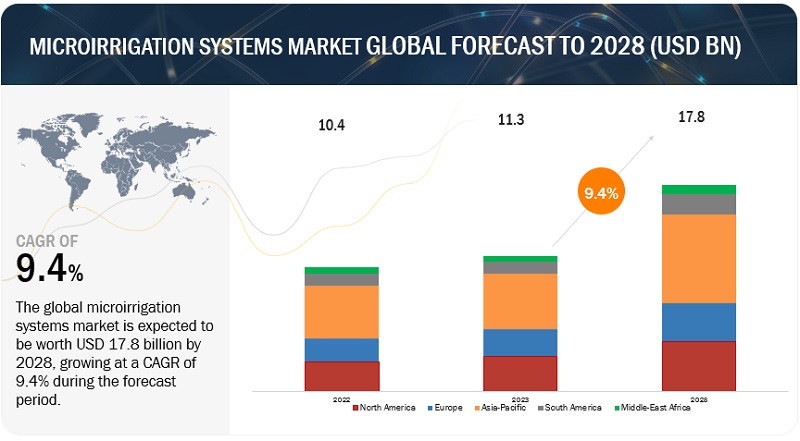
To know about the assumptions considered for the study, Request for Free Sample Report
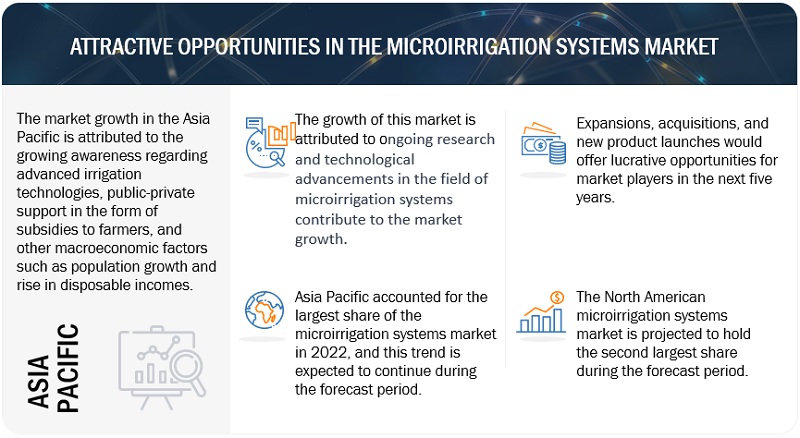
To know about the assumptions considered for the study, download the pdf brochure
Market Dynamics
Driver: Shift from traditional irrigation methods to technologically advanced irrigation systems
The growing awareness about the advantages of micro-sprinkler irrigation among farmers has led to a shift from flood irrigation toward micro-sprinkler systems. The major factor encouraging this trend is a major concern regarding water wastage in flood irrigation, as well as the leaching associated with it. Though the initial capital for the installation of the systems is high, the return on investment associated with the cost after 2-3 years, as well as the availability of a wide range of micro-sprinkler system components, encourage producers to adopt sprinkler irrigation systems. The downward trend of flood irrigation is due to its disadvantages such as poor water-use efficiency, inability to irrigate uneven terrains, and uneven water distribution.
Restraint:High initial investment
Microirrigation systems are best suited for cost-intensive agriculture, such as orchards, nurseries, greenhouses, and vineyards, where conventional irrigation methods may not be practical. Initial investment costs for installing microirrigation are high, and hence, are less suitable for low-value crops, considering that returns on investments may be low. The drawback of microirrigation is the set-up cost of purchasing tubing, emitters, and pumps, particularly for large-scale operations. The cost of microirrigation varies by crop, region, soil & water conditions, grade of pipelines, filtration equipment, fertigation equipment, and the degree of automation desired.
Opportunity: Sustainable agricultural practices of companies
In the last few years, several global food companies have adopted measures to market their products as sustainably produced. This is a differentiating factor in the end products, which has proved to be profitable for companies and has enhanced microirrigation systems market share. Microirrigation systems are one of the means by which these companies can ensure that their raw materials are produced in a sustainable manner. Microirrigation systems reduce the quantity of water consumed by crops, which limits environmental degradation and water table depletion. This is an opportunity for the microirrigation systems market as these agricultural and food companies operate on large scales, either through their farms or through contract farming with small farmers. In the case of contract farming, these companies provide equipment, such as drips and sprinklers, to resource-poor farmers that are essential for the production of crops with desired characteristics.
Challenge: The absence of a proper monitoring agency leads to product duplication
The absence of a proper global monitoring agency leads to product duplication in various regions. This results in the penetration of substandard equipment into the market, causing financial losses to both reliable manufacturers and consumers. A significant amount of revenue is spent by reputed global manufacturers in research & development. Duplication of products leads to tremendous losses borne by manufacturers. A proper monitoring agency needs to be established to monitor licensing and patent issues so that manufacturers become more confident to invest in R&D activities, which will benefit customers.
Microirrigation Systems Market Ecosystem
Prominent companies in this market include well-established, financially stable manufacturers of microirrigation systems. These companies have been operating in the market for several years and possess a diversified product portfolio, state-of-the-art technologies, and strong global sales and marketing networks. Prominent companies in this market include Jain Irrigation Systems Ltd., The Toro Company, Netafim, Nelson Irrigation, and Rain Bird Corporation.
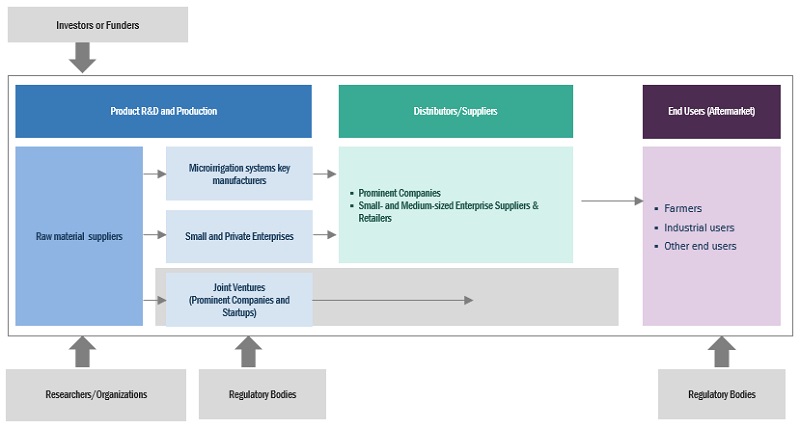
Efficient usage of water resources in drought conditions to drive the demand for microirrigation systems market
Protection of agricultural fields against drought has become a possibility with the use of advanced irrigation systems. Appropriate irrigation scheduling techniques have given various successes among farmers. Irrigation scheduling by advanced technology is gaining importance, and many farmers are increasingly applying these techniques successfully. Through microirrigation, farmers manage to sustain the same production levels even in a drought year, as minimal usage of water resources also ensures high yield with the use of such systems.
The wide range of systems available, including the most basic techniques of recording the readings of water drawn from the resource to the advanced ones that monitor the soil moisture, has helped farmers of different demographics combat water shortages during drought conditions. Farmers can maintain their production levels to ensure high yields with the help of these irrigation systems that require minimal usage of water resources. In addition, with the help of smart irrigation tools, the efficiency of sprinkler irrigation systems is less as compared to those of drip irrigation systems. This is a key factor contributing to the growth of the microirrigation systems market in tropical countries where droughts occur frequently.
Higher yield requirement from a limited area to augment the market growth
Water resources are an essential and critical requirement for crop production, and the extent, regularity, and frequency of water application can be a determining factor in crop quality and yield. Microirrigation systems lead to optimal crop yield by distributing water uniformly to crops. This method is best suited when the water supply is available in insufficient quantities to fulfill the needs of a crop, as it enables farmers to apply water to plant roots. In this way, high crop yield can be achieved with high application efficiency. As the cropland decreases globally with rise in urbanization, the demand for high yield from limited area is expected to rise, thereby augmenting the market for microirrigation systems.
North America is projected to be the second fastest-growing region during the forecast period
North America is the second-fastest growing market for microirrigation systems, and this market is projected to grow at a significant CAGR between 2023 and 2028. North America has traditionally been a large consumer of microirrigation systems. This region has continued to be a major consumer of drip irrigation systems. Freshwater resources are of great environmental and economic importance to the region. However, the distribution of these resources varies across regions. Small farmers in the US are gradually adopting microirrigation systems, primarily due to concerns over water allotment in the midwestern states.
Key players in the North American market include Lindsay Corporation (US), Nelson Irrigation (US), Rain Bird Corporation (US), T-L Irrigation (US), and The Toro Company (US). To gain microirrigation systems market share, these companies are adopting strategies, such as innovative product developments, partnerships, acquisitions, and expansion of existing facilities. The dynamic nature and industry ecosystem coupled with projected rise in demand for microirrigation systems, is catering to the growth of the region in the market.
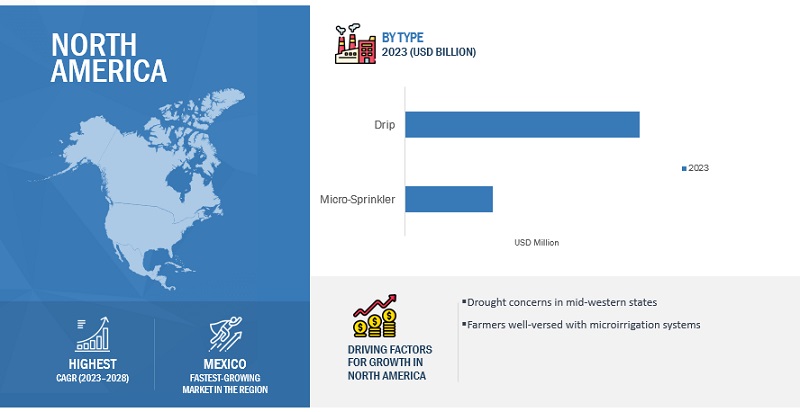
Key Market Players
The key players in this include Jain Irrigation Systems Ltd., The Toro Company, Netafim, Nelson Irrigation, and Rain Bird Corporation. These players in this market are focusing on increasing their presence through acquisitions, product launches, mergers, and collaborations. They have manufacturing facilities along with strong distribution networks across various regions.
Scope of the Report
|
Report Metric |
Details |
|
Market size estimation |
2018–2028 |
|
Base year considered |
2022 |
|
Forecast period considered |
2023–2028 |
|
Units considered |
Value (USD Million/Billion) and Volume (Thousand Hectare) |
|
Segments Covered |
By Type, By Crop Type, By End User, and Region |
|
Regions covered |
North America, Europe, Asia Pacific, South America, and RoW |
|
Companies studied |
|
Report Scope:
Microirrigation Systems Market Segmentation:
By Type
- Drip
- Micro-sprinkler
By Crop Type
- Orchard crops & vineyards
- Field crops
- Plantation crops
- Other crop types (turf & ornamentals, silage, and forage crops)
By End-user
- Farmers
- Industrial users
- Other end users (government authorities, community parks, and playgrounds)
By Region
- North America
- Europe
- Asia Pacific
- South America
- RoW
Recent Developments
- In March 2020, The Toro Company announced the acquisition of Venture Products, Inc (US), which is a premier innovator of equipment for turf and landscape grounds management. The acquisition would help the company to expand its product portfolio in the US.
- In May 2021, Netafim launched the ‘filter’ which will protect irrigation systems against clogging caused by organic contaminants and enable growers to more uniformly irrigate crops, leading to better productivity, cost savings, and peace of mind. AlphaDisc provides the ultimate in irrigation system protection with its combination of precise depth filtration, substantial capacity to contain dirt, and a unique easy-to-scale modular design that helps manage changing flow rates and water quality needs.
Frequently Asked Questions (FAQ):
Which are the major companies in the microirrigation systems market? What are their major strategies to strengthen their market presence?
The major companies in this market include Jain Irrigation Systems Ltd., The Toro Company, Netafim, Nelson Irrigation, and Rain Bird Corporation. These players are focusing on increasing their presence through acquisitions, innovating through product launches, expanding their market shares and strengthening their positions through mergers, and collaborations.
What are the drivers and opportunities for the microirrigation systems market?
The microirrigation systems market is expected to witness significant growth in the forecast period owing to a shift from traditional irrigation systems to more advanced systems, concerns regarding droughts and high yielding pressures on limited land. Opportunities in the market include companies shift towards sustainable agriculture practices.
Which region is expected to hold the highest market share?
The market in Asia Pacific is expected to have the largest market share in 2023, showcasing strong demand for microirrigation systems due to government support to farmers and irrigation projects. The region is also driven by macroeconomic factors such as rise in disposable incomes, a growing population, and fast-growing economies.
What is the Current Market Value Microirrigation Systems Market?
The microirrigation systems market size is estimated to be USD 12.4 billion in 2024 and is expected to grow at a CAGR of 9.4% during the forecast period in terms of value.
What is the total CAGR expected to be recorded for the microirrigation systems market during 2023-2028?
The microirrigation systems market is expected to record a CAGR of 9.4 % during the period 2023-2028.
To speak to our analyst for a discussion on the above findings, click Speak to Analyst


- 5.1 INTRODUCTION
-
5.2 MACROECONOMIC INDICATORSINCREASE IN POPULATION DENSITYDISTRIBUTION AND AVAILABILITY OF WATER FOR IRRIGATION- Rates of water withdrawal- Area under irrigation
-
5.3 MARKET DYNAMICSDRIVERS- Need for efficient use of water resources in drought conditions- Demand for technologically advanced irrigation systems- Low cost of advanced irrigation techniques- High yield requirements for limited area- Rapid growth in greenhouse vegetable production- Preference for use of AI in microirrigation systemsRESTRAINTS- High initial investment- Need for continuous maintenanceOPPORTUNITIES- Global presence of agricultural and food companies- Public and private support for irrigation projects in developing countries- Expanding microfinance networksCHALLENGES- Delayed reimbursement of subsidies- Absence of monitoring agencies
- 6.1 INTRODUCTION
-
6.2 VALUE CHAIN ANALYSISRESEARCH & RAW MATERIALMANUFACTURINGASSEMBLYDISTRIBUTIONMARKETING & SALES
-
6.3 SUPPLY CHAIN ANALYSISPROMINENT COMPANIESSMALL & MEDIUM-SIZED ENTERPRISESEND USERS
-
6.4 TECHNOLOGY ANALYSISPRESSURE-COMPENSATING DRIPPERSSELF-FLUSHING DRIPPERS
-
6.5 PRICE TREND ANALYSISAVERAGE SELLING PRICE, BY TYPE
-
6.6 MARKET MAPPING AND ECOSYSTEM ANALYSISUPSTREAMPROVIDERS OF RAW MATERIALS FOR MICROIRRIGATION SYSTEMSREGULATORY BODIES & CERTIFICATION PROVIDERS
-
6.7 TRENDS/DISRUPTIONS IMPACTING CUSTOMERS’ BUSINESSES
- 6.8 TRADE ANALYSIS
-
6.9 PATENT ANALYSIS
-
6.10 PORTER’S FIVE FORCES ANALYSISINTENSITY OF COMPETITIVE RIVALRYBARGAINING POWER OF SUPPLIERSBARGAINING POWER OF BUYERSTHREAT FROM NEW ENTRANTSTHREAT FROM SUBSTITUTES
-
6.11 CASE STUDIESNETAFIM LIMITED SOUGHT ADVANCED MICROIRRIGATION TECHNOLOGY TO INTEGRATE AUTOMATED IRRIGATION CONTROLKEY PLAYERS FOCUSED ON PARTNERSHIPS AND COLLABORATIONS WITH LOCAL PLAYERS TO PROVIDE HIGH-QUALITY PRODUCTS
- 6.12 TARIFF AND REGULATORY LANDSCAPE
-
6.13 REGULATORY FRAMEWORKNORTH AMERICA- US- CanadaEUROPEASIA PACIFIC- China- India
- 7.1 INTRODUCTION
-
7.2 DRIPINCREASED USE OF CALCIUM ON WIDE RANGE OF CROPS TO FUEL GROWTH OF MICROIRRIGATION SYSTEMS MARKET
-
7.3 MICRO-SPRINKLERNEED FOR HIGH-VALUE CROPS TO DRIVE USE OF MICRO-SPRINKLERS
- 8.1 INTRODUCTION
-
8.2 ORCHARD CROPS & VINEYARDSHIGH-PROFIT MARGINS AND INCREASED EXPORT OF ORCHARD CROPS TO ENCOURAGE ADOPTION OF MICROIRRIGATION SYSTEMS
-
8.3 FIELD CROPSINCREASING CONCERNS OVER WATER SCARCITY IN FIELD CROPS TO DRIVE DEMAND FOR MICROIRRIGATION SYSTEMS
-
8.4 PLANTATION CROPSNEED FOR IMPROVED YIELD AND HIGH AGRICULTURAL EFFICIENCY TO DRIVE DEMAND FOR MICROIRRIGATION SYSTEMS
- 8.5 OTHER CROP TYPES
- 9.1 INTRODUCTION
-
9.2 FARMERSINCREASE IN GOVERNMENT SUPPORT TO DRIVE USE OF MICROIRRIGATION SYSTEMS BY FARMERS
-
9.3 INDUSTRIAL USERSRISING COMMERCIALIZED FARMING IN DEVELOPING COUNTRIES TO DRIVE DEMAND FOR MICROIRRIGATION SYSTEMS
- 9.4 OTHER END USERS
- 10.1 INTRODUCTION
-
10.2 NORTH AMERICARECESSION IMPACT ANALYSISUS- Federal subsidies and increase in scope of automation to drive adoption of microirrigation systemsCANADA- Increase in agricultural production and awareness among farmers to drive demand for microirrigation systemsMEXICO- Government policies and high water tariffs to encourage farmers to adopt microirrigation systems
-
10.3 EUROPERECESSION IMPACT ANALYSISSPAIN- Increased cultivation to drive demand for efficient irrigation systemsRUSSIA- Scarcity of rainfall to drive demand for efficient irrigation technologiesITALY- Abundance of vineyards to encourage demand for microirrigation systemsFRANCE- Rise in population and increased food production to drive microirrigation systems market growthUKRAINE- Increased export of grains, oilseeds, and vegetable oils to drive use of microirrigation systemsAZERBAIJAN- Consistent efforts by government to supplement deployment of microirrigation systems to drive market growthREST OF EUROPE
-
10.4 ASIA PACIFICRECESSION IMPACT ANALYSISCHINA- Increase in market reach of domestic players and government support to drive microirrigation systems market growthAUSTRALIA- High water tariffs and government incentives for water conservation to drive growth of drip irrigation marketINDIA- Government subsidies and concerns over water scarcity to encourage drip irrigation market growthTHAILAND- Rise in government support to encourage growth of microirrigation systemsINDONESIA- Need for increased agricultural productivity to drive use of microirrigation systemsPHILIPPINES- Substantial increase in irrigated land to drive microirrigation systems market growthUZBEKISTAN- Water scarcity and arid conditions to drive demand for microirrigation systemsKAZAKHSTAN- Increase in employment in agricultural sector to contribute to growth of microirrigation systems marketREST OF ASIA PACIFIC
-
10.5 SOUTH AMERICARECESSION IMPACT ANALYSISBRAZIL- Increase in government regulations on water use to support growth of microirrigation systems marketARGENTINA- Rising government initiatives to encourage growth of microirrigation systems marketCOLOMBIA- High growth potential of irrigation technologies to drive microirrigation systems marketPERU- Government initiatives to expand irrigation industry to contribute to growth of microirrigation systems marketCHILE- Water scarcity and drought-like conditions to drive use of advanced microirrigation systemsREST OF SOUTH AMERICA
-
10.6 REST OF THE WORLDRECESSION IMPACT ANALYSISSOUTH AFRICA- Demand for drip irrigation systems among small-scale farmers to drive microirrigation systems marketSAUDI ARABIA- Increasing use of microirrigation methods for greenhouse production to drive market demandOTHERS IN ROW

- 11.1 OVERVIEW
- 11.2 STRATEGIES ADOPTED BY KEY PLAYERS
- 11.3 MARKET SHARE ANALYSIS
- 11.4 REVENUE ANALYSIS FOR KEY PLAYERS
-
11.5 EVALUATION QUADRANT MATRIX FOR KEY PLAYERSSTARSEMERGING LEADERSPERVASIVE PLAYERSPARTICIPANTSCOMPANY FOOTPRINT FOR KEY PLAYERS
-
11.6 EVALUATION QUADRANT MATRIX FOR OTHER PLAYERSPROGRESSIVE COMPANIESSTARTING BLOCKSRESPONSIVE COMPANIESDYNAMIC COMPANIESCOMPETITIVE BENCHMARKING FOR OTHER PLAYERS
-
11.7 COMPETITIVE SCENARIOPRODUCT LAUNCHESDEALSOTHERS
-
12.1 KEY PLAYERSJAIN IRRIGATION SYSTEMS LTD.- Business overview- Products/Solutions/Services offered- Recent developments- MnM viewTHE TORO COMPANY- Business overview- Products/Solutions/Services offered- Recent developments- MnM viewNETAFIM- Business overview- Products/Solutions/Services offered- Recent developments- MnM viewNELSON IRRIGATION- Business overview- Products/Solutions/Services offered- MnM viewRAIN BIRD CORPORATION- Business overview- Products/Solutions/Services offered- Recent developments- MnM viewFINOLEX PLASSON- Business overview- Products/Solutions/Services offered- MnM viewMAHINDRA EPC IRRIGATION LIMITED- Business overview- Products/Solutions/Services offered- MnM viewT-L IRRIGATION- Business overview- Products/Solutions/Services offered- MnM viewHUNTER INDUSTRIES- Business overview- Products/Solutions/Services offered- Recent developments- MnM viewRIVULIS- Business overview- Products/Solutions/Services offered- Recent developments- MnM viewCHINADRIP IRRIGATION EQUIPMENT CO., LTD.- Business overview- Products/Solutions/Services offered- Recent developments- MnM viewELGO IRRIGATION LTD.- Business overview- Products/Solutions/Services offered- MnM viewANTELCO- Business overview- Products/Solutions/Services offered- MnM viewMICROJET- Business overview- Products/Solutions/Services offered- MnM viewIRRITEC S.P.A- Business overview- Products/Solutions/Services offered- Recent developments- MnM view
-
12.2 OTHER PLAYERSRAINDRIP- Business overview- Products/Solutions/Services offeredKOTHARI GROUP- Business overview- Products/Solutions/Services offeredMETRO IRRIGATION- Business overview- Products/Solutions/Services offeredDRTS- Business overview- Products/Solutions/Services offeredDRIPWORKS- Business overview- Products/Solutions/Services offeredHARVEL AGUA INDIA PRIVATE LIMITEDJALDHARADRIPSHANGHAI IRRIST CORP. LTD.GOLDENKEYHEIBEI PLENTIRAIN IRRIGATION EQUIPMENT LTD.
- 13.1 INTRODUCTION
- 13.2 LIMITATIONS
-
13.3 DRIP IRRIGATION MARKETMARKET DEFINITIONMARKET OVERVIEW
-
13.4 IRRIGATION AUTOMATION MARKETMARKET DEFINITIONMARKET OVERVIEW
- 14.1 DISCUSSION GUIDE
- 14.2 KNOWLEDGESTORE: MARKETSANDMARKETS’ SUBSCRIPTION PORTAL
- 14.3 CUSTOMIZATION OPTIONS
- 14.4 RELATED REPORTS
- 14.5 AUTHOR DETAILS
- TABLE 1 USD EXCHANGE RATES, 2018–2022
- TABLE 2 MICROIRRIGATION SYSTEMS MARKET SNAPSHOT, 2023 VS. 2028
- TABLE 3 COUNTRIES WITH LARGEST AGRICULTURAL WATER WITHDRAWALS IN 2020
- TABLE 4 LAND AREA EQUIPPED FOR IRRIGATION, BY KEY COUNTRY, 2019
- TABLE 5 COMPARISON BETWEEN FLOOD IRRIGATION AND CENTER PIVOT SYSTEMS
- TABLE 6 COMPARISON OF WATER REQUIREMENTS IN DRIP AND SURFACE IRRIGATION FOR HORTICULTURAL CROPS
- TABLE 7 YIELD IMPROVEMENT USING DRIP IRRIGATION, BY CROP, 2019
- TABLE 8 COST OF MICRO-SPRINKLER IRRIGATION SYSTEMS
- TABLE 9 COST OF DRIP IRRIGATION SYSTEMS
- TABLE 10 COMPARISON OF OPERATING COSTS FOR DIFFERENT SPRINKLER SYSTEMS
- TABLE 11 MICROIRRIGATION SYSTEMS: AVERAGE SELLING PRICE, BY REGION, 2020–2022 (USD PER HECTARE)
- TABLE 12 AVERAGE SELLING PRICE OFFERED BY KEY PLAYERS, BY TYPE, 2022 (USD PER HECTARE)
- TABLE 13 SUPPLY CHAIN ECOSYSTEM
- TABLE 14 EXPORT VALUE OF DISPERSING APPLIANCES, BY KEY COUNTRY, 2022
- TABLE 15 IMPORT VALUE OF DISPERSING APPLIANCES, BY KEY COUNTRY, 2022
- TABLE 16 EXPORT VALUE OF DISPERSING APPLIANCES, BY KEY COUNTRY, 2021
- TABLE 17 IMPORT VALUE OF DISPERSING APPLIANCES, BY KEY COUNTRY, 2021
- TABLE 18 PATENTS PERTAINING TO MICROIRRIGATION SYSTEMS, 2013–2022
- TABLE 19 PORTER’S FIVE FORCES ANALYSIS
- TABLE 20 NORTH AMERICA: REGULATORY BODIES, GOVERNMENT AGENCIES, AND OTHER ORGANIZATIONS
- TABLE 21 EUROPE: REGULATORY BODIES, GOVERNMENT AGENCIES, AND OTHER ORGANIZATIONS
- TABLE 22 ASIA PACIFIC: REGULATORY BODIES, GOVERNMENT AGENCIES, AND OTHER ORGANIZATIONS
- TABLE 23 SOUTH AMERICA: REGULATORY BODIES, GOVERNMENT AGENCIES, AND OTHER ORGANIZATIONS
- TABLE 24 QUALITY PARAMETERS FOR LATERALS
- TABLE 25 MICROIRRIGATION SYSTEMS MARKET, BY TYPE, 2018–2022 (000’ HECTARES)
- TABLE 26 MICROIRRIGATION SYSTEMS MARKET, BY TYPE, 2023–2028 (000’ HECTARES)
- TABLE 27 MICROIRRIGATION SYSTEMS MARKET, BY TYPE, 2018–2022 (USD MILLION)
- TABLE 28 MICROIRRIGATION SYSTEMS MARKET, BY TYPE, 2023–2028 (USD MILLION)
- TABLE 29 DRIP: MICROIRRIGATION SYSTEMS MARKET, BY REGION, 2018–2022 (000’ HECTARES)
- TABLE 30 DRIP: MARKET, BY REGION, 2023–2028 (000’ HECTARES)
- TABLE 31 DRIP: MARKET, BY REGION, 2018–2022 (USD MILLION)
- TABLE 32 DRIP: MARKET, BY REGION, 2023–2028 (USD MILLION)
- TABLE 33 MICRO-SPRINKLER: MICROIRRIGATION SYSTEMS MARKET, BY REGION, 2018–2022 (000’ HECTARES)
- TABLE 34 MICRO-SPRINKLER: MARKET, BY REGION, 2023–2028 (000’ HECTARES)
- TABLE 35 MICRO-SPRINKLER: MARKET, BY REGION, 2018–2022 (USD MILLION)
- TABLE 36 MICRO-SPRINKLER: MARKET, BY REGION, 2023–2028 (USD MILLION)
- TABLE 37 MICROIRRIGATION SYSTEMS MARKET, BY CROP TYPE, 2018–2022 (USD MILLION)
- TABLE 38 MICROIRRIGATION SYSTEMS MARKET, BY CROP TYPE, 2023–2028 (USD MILLION)
- TABLE 39 ORCHARD CROPS & VINEYARDS: MICROIRRIGATION SYSTEMS MARKET, BY REGION, 2018–2022 (USD MILLION)
- TABLE 40 ORCHARD CROPS & VINEYARDS: MARKET, BY REGION, 2023–2028 (USD MILLION)
- TABLE 41 FIELD CROPS: MICROIRRIGATION SYSTEMS MARKET, BY REGION, 2018–2022 (USD MILLION)
- TABLE 42 FIELD CROPS: MARKET, BY REGION, 2023–2028 (USD MILLION)
- TABLE 43 PLANTATION CROPS: MICROIRRIGATION SYSTEMS MARKET, BY REGION, 2018–2022 (USD MILLION)
- TABLE 44 PLANTATION CROPS: MARKET, BY REGION, 2023–2028 (USD MILLION)
- TABLE 45 OTHER CROP TYPES: MICROIRRIGATION SYSTEMS MARKET, BY REGION, 2018–2022 (USD MILLION)
- TABLE 46 OTHER CROP TYPES: MARKET, 2023–2028 (USD MILLION)
- TABLE 47 MICROIRRIGATION SYSTEMS MARKET, BY END USER, 2018–2022 (USD MILLION)
- TABLE 48 MICROIRRIGATION SYSTEMS MARKET, BY END USER, 2023–2028 (USD MILLION)
- TABLE 49 FARMERS: MICROIRRIGATION SYSTEMS MARKET, BY REGION, 2018–2022 (USD MILLION)
- TABLE 50 FARMERS: MICROIRRIGATION SYSTEMS MARKET, BY REGION, 2023–2028 (USD MILLION)
- TABLE 51 INDUSTRIAL USERS: MICROIRRIGATION SYSTEMS MARKET, BY REGION, 2018–2022 (USD MILLION)
- TABLE 52 INDUSTRIAL USERS: MARKET, BY REGION, 2023–2028 (USD MILLION)
- TABLE 53 OTHER END USERS: MARKET, BY REGION, 2018–2022 (USD MILLION)
- TABLE 54 OTHER END USERS: MARKET, BY REGION, 2023–2028 (USD MILLION)
- TABLE 55 MICROIRRIGATION SYSTEMS MARKET, BY REGION, 2018–2022 (000’ HECTARES)
- TABLE 56 MICROIRRIGATION SYSTEMS MARKET, BY REGION, 2023–2028 (000’ HECTARES)
- TABLE 57 MICROIRRIGATION SYSTEMS MARKET, BY REGION, 2018–2022 (USD MILLION)
- TABLE 58 MICROIRRIGATION SYSTEMS MARKET, BY REGION, 2023–2028 (USD MILLION)
- TABLE 59 NORTH AMERICA: MICROIRRIGATION SYSTEMS MARKET, BY COUNTRY, 2018–2022 (000’ HECTARES)
- TABLE 60 NORTH AMERICA: MARKET, BY COUNTRY, 2023–2028 (000’ HECTARES)
- TABLE 61 NORTH AMERICA: MARKET, BY COUNTRY, 2018–2022 (USD MILLION)
- TABLE 62 NORTH AMERICA: MARKET, BY COUNTRY, 2023–2028 (USD MILLION)
- TABLE 63 NORTH AMERICA: MARKET, BY COUNTRY, 2023–2028 (000’ HECTARES)
- TABLE 64 NORTH AMERICA: MARKET, BY TYPE, 2018–2022 (000’ HECTARES)
- TABLE 65 NORTH AMERICA: MARKET, BY TYPE, 2018–2022 (USD MILLION)
- TABLE 66 NORTH AMERICA: MARKET, BY TYPE, 2023–2028 (USD MILLION)
- TABLE 67 NORTH AMERICA: MARKET, BY END USER, 2018–2022 (USD MILLION)
- TABLE 68 NORTH AMERICA: MARKET, BY END USER, 2023–2028 (USD MILLION)
- TABLE 69 NORTH AMERICA: MICROIRRIGATION SYSTEMS MARKET, BY CROP TYPE, 2018–2022 (USD MILLION)
- TABLE 70 NORTH AMERICA: MICROIRRIGATION SYSTEMS MARKET, BY CROP TYPE, 2023–2028 (USD MILLION)
- TABLE 71 US: MICROIRRIGATION SYSTEMS MARKET, BY TYPE, 2018–2022 (000’ HECTARES)
- TABLE 72 US: MARKET, BY TYPE, 2023–2028 (000’ HECTARES)
- TABLE 73 US: MARKET, BY TYPE, 2018–2022 (USD MILLION)
- TABLE 74 US: MARKET, BY TYPE, 2023–2028 (USD MILLION)
- TABLE 75 CANADA: MICROIRRIGATION SYSTEMS MARKET, BY TYPE, 2018–2022 (000’ HECTARES)
- TABLE 76 CANADA: MARKET, BY TYPE, 2023–2028 (000’ HECTARES)
- TABLE 77 CANADA: MARKET, BY TYPE, 2018–2022 (USD MILLION)
- TABLE 78 CANADA: MARKET, BY TYPE, 2023–2028 (USD MILLION)
- TABLE 79 MEXICO: MICROIRRIGATION SYSTEMS MARKET, BY TYPE, 2018–2022 (000’ HECTARES)
- TABLE 80 MEXICO: MARKET, BY TYPE, 2023–2028 (000’ HECTARES)
- TABLE 81 MEXICO: MARKET, BY TYPE, 2018–2022 (USD MILLION)
- TABLE 82 MEXICO: MARKET, BY TYPE, 2023–2028 (USD MILLION)
- TABLE 83 EUROPE: MICROIRRIGATION SYSTEMS MARKET, BY COUNTRY, 2018–2022 (000’ HECTARES)
- TABLE 84 EUROPE: MARKET, BY COUNTRY, 2023–2028 (000’ HECTARES)
- TABLE 85 EUROPE: MARKET, BY COUNTRY, 2018–2022 (USD MILLION)
- TABLE 86 EUROPE: MARKET, BY COUNTRY, 2023–2028 (USD MILLION)
- TABLE 87 EUROPE: MARKET, BY TYPE, 2018–2022 (000’ HECTARES)
- TABLE 88 EUROPE: MARKET, BY TYPE, 2023–2028 (000’ HECTARES)
- TABLE 89 EUROPE: MARKET, BY TYPE, 2018–2022 (USD MILLION)
- TABLE 90 EUROPE: MARKET, BY TYPE, 2023–2028 (USD MILLION)
- TABLE 91 EUROPE: MARKET, BY END USER, 2018–2022 (USD MILLION)
- TABLE 92 EUROPE: MARKET, BY END USER, 2023–2028 (USD MILLION)
- TABLE 93 EUROPE: MARKET, BY CROP TYPE, 2018–2022 (USD MILLION)
- TABLE 94 EUROPE: MARKET, BY CROP TYPE, 2023–2028 (USD MILLION)
- TABLE 95 SPAIN: MICROIRRIGATION SYSTEMS MARKET, BY TYPE, 2018–2022 (000’ HECTARES)
- TABLE 96 SPAIN: MARKET, BY TYPE, 2023–2028 (000’ HECTARES)
- TABLE 97 SPAIN: MARKET, BY TYPE, 2018–2022 (USD MILLION)
- TABLE 98 SPAIN: MARKET, BY TYPE, 2023–2028 (USD MILLION)
- TABLE 99 RUSSIA: MICROIRRIGATION SYSTEMS MARKET, BY TYPE, 2018–2022 (000’ HECTARES)
- TABLE 100 RUSSIA: MARKET, BY TYPE, 2023–2028 (000’ HECTARES)
- TABLE 101 RUSSIA: MICROIRRIGATION SYSTEMS MARKET, BY TYPE, 2018–2022 (USD MILLION)
- TABLE 102 RUSSIA: MARKET, BY TYPE, 2023–2028 (USD MILLION)
- TABLE 103 ITALY: MICROIRRIGATION SYSTEMS MARKET, BY TYPE, 2018–2022 (000’ HECTARES)
- TABLE 104 ITALY: MARKET, BY TYPE, 2023–2028 (000’ HECTARES)
- TABLE 105 ITALY: MARKET, BY TYPE, 2018–2022 (USD MILLION)
- TABLE 106 ITALY: MARKET, BY TYPE, 2023–2028 (USD MILLION)
- TABLE 107 FRANCE: MICROIRRIGATION SYSTEMS MARKET, BY TYPE, 2018–2022 (000’ HECTARES)
- TABLE 108 FRANCE: MARKET, BY TYPE, 2023–2028 (000’ HECTARES)
- TABLE 109 FRANCE: MARKET, BY TYPE, 2018–2022 (USD MILLION)
- TABLE 110 FRANCE: MARKET, BY TYPE, 2023–2028 (USD MILLION)
- TABLE 111 UKRAINE: MARKET, BY TYPE, 2018–2022 (000’ HECTARES)
- TABLE 112 UKRAINE: MARKET, BY TYPE, 2023–2028 (000’ HECTARES)
- TABLE 113 UKRAINE: MARKET, BY TYPE, 2018–2022 (USD MILLION)
- TABLE 114 UKRAINE: MARKET, BY TYPE, 2023–2028 (USD MILLION)
- TABLE 115 AZERBAIJAN: MICROIRRIGATION SYSTEMS MARKET, BY TYPE, 2018–2022 (000’ HECTARES)
- TABLE 116 AZERBAIJAN: MARKET, BY TYPE, 2023–2028 (000’ HECTARES)
- TABLE 117 AZERBAIJAN: MARKET, BY TYPE, 2018–2022 (USD THOUSAND)
- TABLE 118 AZERBAIJAN: MARKET, BY TYPE, 2023–2028 (USD THOUSAND)
- TABLE 119 REST OF EUROPE: MICROIRRIGATION SYSTEMS MARKET, BY TYPE, 2018–2022 (000’ HECTARES)
- TABLE 120 REST OF EUROPE: MARKET, BY TYPE, 2023–2028 (000’ HECTARES)
- TABLE 121 REST OF EUROPE: MARKET, BY TYPE, 2018–2022 (USD MILLION)
- TABLE 122 REST OF EUROPE: MARKET, BY TYPE, 2023–2028 (USD MILLION)
- TABLE 123 ASIA PACIFIC: MICROIRRIGATION SYSTEMS MARKET, BY COUNTRY, 2018–2022 (000’ HECTARES)
- TABLE 124 ASIA PACIFIC: MARKET, BY COUNTRY, 2023–2028 (000’ HECTARES)
- TABLE 125 ASIA PACIFIC: MARKET, BY COUNTRY, 2018–2022 (USD MILLION)
- TABLE 126 ASIA PACIFIC: MARKET, BY COUNTRY, 2023–2028 (USD MILLION)
- TABLE 127 ASIA PACIFIC: MARKET, BY TYPE, 2018–2022 (000’ HECTARES)
- TABLE 128 ASIA PACIFIC: MARKET, BY TYPE, 2023–2028 (000’ HECTARES)
- TABLE 129 ASIA PACIFIC: MARKET, BY TYPE, 2018–2022 (USD MILLION)
- TABLE 130 ASIA PACIFIC: MARKET, BY TYPE, 2023–2028 (USD MILLION)
- TABLE 131 ASIA PACIFIC: MARKET, BY END USER, 2018–2022 (USD MILLION)
- TABLE 132 ASIA PACIFIC: MARKET, BY END USER, 2023–2028 (USD MILLION)
- TABLE 133 ASIA PACIFIC: MARKET, BY CROP TYPE, 2018–2022 (USD MILLION)
- TABLE 134 ASIA PACIFIC: MARKET, BY CROP TYPE, 2023–2028 (USD MILLION)
- TABLE 135 CHINA: MICROIRRIGATION SYSTEMS MARKET, BY TYPE, 2018–2022 (000’ HECTARES)
- TABLE 136 CHINA: MARKET, BY TYPE, 2023–2028 (000’ HECTARES)
- TABLE 137 CHINA: MARKET, BY TYPE, 2018–2022 (USD MILLION)
- TABLE 138 CHINA: MARKET, BY TYPE, 2023–2028 (USD MILLION)
- TABLE 139 AUSTRALIA: MICROIRRIGATION SYSTEMS MARKET, BY TYPE, 2018–2022 (000’ HECTARES)
- TABLE 140 AUSTRALIA: MARKET, BY TYPE, 2023–2028 (000’ HECTARES)
- TABLE 141 AUSTRALIA: MARKET, BY TYPE, 2018–2022 (USD MILLION)
- TABLE 142 AUSTRALIA: MARKET, BY TYPE, 2023–2028 (USD MILLION)
- TABLE 143 INDIA: MICROIRRIGATION SYSTEMS MARKET, BY TYPE, 2018–2022 (000’ HECTARES)
- TABLE 144 INDIA: MARKET, BY TYPE, 2023–2028 (000’ HECTARES)
- TABLE 145 INDIA: MARKET, BY TYPE, 2018–2022 (USD MILLION)
- TABLE 146 INDIA: MARKET, BY TYPE, 2023–2028 (USD MILLION)
- TABLE 147 THAILAND: MICROIRRIGATION SYSTEMS MARKET, BY TYPE, 2018–2022 (000’ HECTARES)
- TABLE 148 THAILAND: MARKET, BY TYPE, 2023–2028 (000’ HECTARES)
- TABLE 149 THAILAND: MARKET, BY TYPE, 2018–2022 (USD MILLION)
- TABLE 150 THAILAND: MARKET, BY TYPE, 2023–2028 (USD MILLION)
- TABLE 151 INDONESIA: MICROIRRIGATION SYSTEMS MARKET, BY TYPE, 2018–2022 (000’ HECTARES)
- TABLE 152 INDONESIA: MARKET, BY TYPE, 2023–2028 (000’ HECTARES)
- TABLE 153 INDONESIA: MARKET, BY TYPE, 2018–2022 (USD MILLION)
- TABLE 154 INDONESIA: MARKET, BY TYPE, 2023–2028 (USD MILLION)
- TABLE 155 PHILIPPINES: MICROIRRIGATION SYSTEMS MARKET, BY TYPE, 2018–2022 (000’ HECTARES)
- TABLE 156 PHILIPPINES: MARKET, BY TYPE, 2023–2028 (000’ HECTARES)
- TABLE 157 PHILIPPINES: MARKET, BY TYPE, 2018–2022 (USD MILLION)
- TABLE 158 PHILIPPINES: MARKET, BY TYPE, 2023–2028 (USD MILLION)
- TABLE 159 UZBEKISTAN: MARKET, BY TYPE, 2018–2022 (000’ HECTARES)
- TABLE 160 UZBEKISTAN: MARKET, BY TYPE, 2023–2028 (000’ HECTARES)
- TABLE 161 UZBEKISTAN: MARKET, BY TYPE, 2018–2022 (USD MILLION)
- TABLE 162 UZBEKISTAN: MARKET, BY TYPE, 2023–2028 (USD MILLION)
- TABLE 163 KAZAKHSTAN: MARKET, BY TYPE, 2018–2022 (000’ HECTARES)
- TABLE 164 KAZAKHSTAN: MARKET, BY TYPE, 2023–2028 (000’ HECTARES)
- TABLE 165 KAZAKHSTAN: MARKET, BY TYPE, 2018–2022 (USD THOUSAND)
- TABLE 166 KAZAKHSTAN: MARKET, BY TYPE, 2023–2028 (USD THOUSAND)
- TABLE 167 REST OF ASIA PACIFIC: MICROIRRIGATION SYSTEMS MARKET, BY TYPE, 2018–2022 (000’ HECTARES)
- TABLE 168 REST OF ASIA PACIFIC: MARKET, BY TYPE, 2023–2028 (000’ HECTARES)
- TABLE 169 REST OF ASIA PACIFIC: MARKET, BY TYPE, 2018–2022 (USD MILLION)
- TABLE 170 REST OF ASIA PACIFIC: MICROIRRIGATION SYSTEMS MARKET, BY TYPE, 2023–2028 (USD MILLION)
- TABLE 171 SOUTH AMERICA: MICROIRRIGATION SYSTEMS MARKET, BY COUNTRY, 2018–2022 (000’ HECTARES)
- TABLE 172 SOUTH AMERICA: MARKET, BY COUNTRY, 2023–2028 (000’ HECTARES)
- TABLE 173 SOUTH AMERICA: MARKET, BY COUNTRY, 2018–2022 (USD MILLION)
- TABLE 174 SOUTH AMERICA: MARKET, BY COUNTRY, 2023–2028 (USD MILLION)
- TABLE 175 SOUTH AMERICA: MARKET, BY TYPE, 2018–2022 (000’ HECTARES)
- TABLE 176 SOUTH AMERICA: MARKET, BY TYPE, 2023–2028 (000’ HECTARE)
- TABLE 177 SOUTH AMERICA: MARKET, BY TYPE, 2018–2022 (USD MILLION)
- TABLE 178 SOUTH AMERICA: MARKET, BY TYPE, 2023–2028 (USD MILLION)
- TABLE 179 SOUTH AMERICA: MARKET, BY END USER, 2018–2022 (USD MILLION)
- TABLE 180 SOUTH AMERICA: MARKET, BY END USER, 2023–2028 (USD MILLION)
- TABLE 181 SOUTH AMERICA: MARKET, BY CROP TYPE, 2018–2022 (USD MILLION)
- TABLE 182 SOUTH AMERICA: MARKET, BY CROP TYPE, 2023–2028 (USD MILLION)
- TABLE 183 BRAZIL: MICROIRRIGATION SYSTEMS MARKET, BY TYPE, 2018–2022 (000’ HECTARES)
- TABLE 184 BRAZIL: MARKET, BY TYPE, 2023–2028 (000’ HECTARES)
- TABLE 185 BRAZIL: MARKET, BY TYPE, 2018–2022 (USD MILLION)
- TABLE 186 BRAZIL: MARKET, BY TYPE, 2023–2028 (USD MILLION)
- TABLE 187 ARGENTINA: MICROIRRIGATION SYSTEMS MARKET, BY TYPE, 2018–2022 (000’ HECTARES)
- TABLE 188 ARGENTINA: MARKET, BY TYPE, 2023–2028 (000’ HECTARES)
- TABLE 189 ARGENTINA: MARKET, BY TYPE, 2018–2022 (USD MILLION)
- TABLE 190 ARGENTINA: MARKET, BY TYPE, 2023–2028 (USD MILLION)
- TABLE 191 COLOMBIA: MICROIRRIGATION SYSTEMS MARKET, BY TYPE, 2018–2022 (000’ HECTARES)
- TABLE 192 COLOMBIA: MARKET, BY TYPE, 2023–2028 (000’ HECTARES)
- TABLE 193 COLOMBIA: MARKET, BY TYPE, 2018–2022 (USD MILLION)
- TABLE 194 COLOMBIA: MARKET, BY TYPE, 2023–2028 (USD MILLION)
- TABLE 195 PERU: MICROIRRIGATION SYSTEMS MARKET, BY TYPE, 2018–2022 (000’ HECTARES)
- TABLE 196 PERU: MARKET, BY TYPE, 2023–2028 (000’ HECTARES)
- TABLE 197 PERU: MARKET, BY TYPE, 2018–2022 (USD MILLION)
- TABLE 198 PERU: MARKET, BY TYPE, 2023–2028 (USD MILLION)
- TABLE 199 CHILE: MARKET, BY TYPE, 2018–2022 (000’ HECTARES)
- TABLE 200 CHILE: MARKET, BY TYPE, 2023–2028 (000’ HECTARES)
- TABLE 201 CHILE: MARKET, BY TYPE, 2018–2022 (USD MILLION)
- TABLE 202 CHILE: MARKET, BY TYPE, 2023–2028 (USD MILLION)
- TABLE 203 REST OF SOUTH AMERICA: MICROIRRIGATION SYSTEMS MARKET, BY TYPE, 2018–2022 (000’ HECTARES)
- TABLE 204 REST OF SOUTH AMERICA: MARKET, BY TYPE, 2023–2028 (000’ HECTARES)
- TABLE 205 REST OF SOUTH AMERICA: MARKET, BY TYPE, 2018–2022 (USD MILLION)
- TABLE 206 REST OF SOUTH AMERICA: MARKET, BY TYPE, 2023–2028 (USD MILLION)
- TABLE 207 ROW: MICROIRRIGATION SYSTEMS MARKET, BY COUNTRY/REGION, 2018–2022 (000’ HECTARES)
- TABLE 208 ROW: MARKET, BY COUNTRY/REGION, 2023–2028 (000’ HECTARES)
- TABLE 209 ROW: MARKET, BY COUNTRY/REGION, 2018–2022 (USD MILLION)
- TABLE 210 ROW: MARKET, BY COUNTRY/REGION, 2023–2028 (USD MILLION)
- TABLE 211 ROW: MARKET, BY TYPE, 2018–2022 (000’ HECTARES)
- TABLE 212 ROW: MARKET, BY TYPE, 2023–2028 (000’ HECTARES)
- TABLE 213 ROW: MARKET, BY TYPE, 2018–2022 (USD MILLION)
- TABLE 214 ROW: MARKET, BY TYPE, 2023–2028 (USD MILLION)
- TABLE 215 ROW: MARKET, BY END USER, 2018–2022 (USD MILLION)
- TABLE 216 ROW: MARKET, BY END USER, 2023–2028 (USD MILLION)
- TABLE 217 ROW: MARKET, BY CROP TYPE, 2018–2022 (USD MILLION)
- TABLE 218 ROW: MARKET, BY CROP TYPE, 2023–2028 (USD MILLION)
- TABLE 219 SOUTH AFRICA: MICROIRRIGATION SYSTEMS MARKET, BY TYPE, 2018–2022 (000’ HECTARES)
- TABLE 220 SOUTH AFRICA: MARKET, BY TYPE, 2023–2028 (000’ HECTARES)
- TABLE 221 SOUTH AFRICA: MARKET, BY TYPE, 2018–2022 (USD MILLION)
- TABLE 222 SOUTH AFRICA: MARKET, BY TYPE, 2023–2028 (USD MILLION)
- TABLE 223 SAUDI ARABIA: MICROIRRIGATION SYSTEMS MARKET, BY TYPE, 2018–2022 (000’ HECTARES)
- TABLE 224 SAUDI ARABIA: MARKET, BY TYPE, 2023–2028 (000’ HECTARES)
- TABLE 225 SAUDI ARABIA: MARKET, BY TYPE, 2018–2022 (USD MILLION)
- TABLE 226 SAUDI ARABIA: MARKET, BY TYPE, 2023–2028 (USD MILLION)
- TABLE 227 OTHERS IN ROW: MICROIRRIGATION SYSTEMS MARKET, BY TYPE, 2018–2022 (000’ HECTARES)
- TABLE 228 OTHERS IN ROW: MARKET, BY TYPE, 2023–2028 (000’ HECTARES)
- TABLE 229 OTHERS IN ROW: MARKET, BY TYPE, 2018–2022 (USD MILLION)
- TABLE 230 OTHERS IN ROW: MARKET, BY TYPE, 2023–2028 (USD MILLION)
- TABLE 231 MICROIRRIGATION SYSTEMS MARKET: INTENSITY OF COMPETITIVE RIVALRY
- TABLE 232 COMPANY FOOTPRINT FOR KEY PLAYERS, BY TYPE
- TABLE 233 COMPANY FOOTPRINT FOR KEY PLAYERS, BY CROP TYPE
- TABLE 234 COMPANY FOOTPRINT FOR KEY PLAYERS, BY REGION
- TABLE 235 COMPANY OVERALL FOOTPRINT FOR KEY PLAYERS
- TABLE 236 DETAILED LIST OF OTHER PLAYERS
- TABLE 237 COMPETITIVE BENCHMARKING FOR OTHER PLAYERS, 2022
- TABLE 238 MICROIRRIGATION SYSTEMS MARKET: PRODUCT LAUNCHES, 2020–2021
- TABLE 239 MICROIRRIGATION SYSTEMS MARKET: DEALS, 2020–2023
- TABLE 240 MICROIRRIGATION SYSTEMS MARKET: OTHERS, 2021–2023
- TABLE 241 JAIN IRRIGATION SYSTEMS LTD.: BUSINESS OVERVIEW
- TABLE 242 JAIN IRRIGATION SYSTEMS LTD.: PRODUCT LAUNCHES
- TABLE 243 JAIN IRRIGATION SYSTEMS LTD.: DEALS
- TABLE 244 THE TORO COMPANY: BUSINESS OVERVIEW
- TABLE 245 THE TORO COMPANY: PRODUCT LAUNCHES
- TABLE 246 THE TORO COMPANY: DEALS
- TABLE 247 NETAFIM: BUSINESS OVERVIEW
- TABLE 248 NETAFIM: PRODUCT LAUNCHES
- TABLE 249 NETAFIM: DEALS
- TABLE 250 NETAFIM: OTHERS
- TABLE 251 NELSON IRRIGATION: BUSINESS OVERVIEW
- TABLE 252 RAIN BIRD CORPORATION: BUSINESS OVERVIEW
- TABLE 253 RAIN BIRD CORPORATION: PRODUCT LAUNCHES
- TABLE 254 FINOLEX PLASSON: BUSINESS OVERVIEW
- TABLE 255 MAHINDRA EPC IRRIGATION LIMITED: BUSINESS OVERVIEW
- TABLE 256 T-L IRRIGATION: BUSINESS OVERVIEW
- TABLE 257 HUNTER INDUSTRIES: BUSINESS OVERVIEW
- TABLE 258 HUNTER INDUSTRIES: PRODUCT LAUNCHES
- TABLE 259 RIVULIS: BUSINESS OVERVIEW
- TABLE 260 RIVULIS: DEALS
- TABLE 261 RIVULIS: OTHERS
- TABLE 262 CHINADRIP IRRIGATION EQUIPMENT CO., LTD.: BUSINESS OVERVIEW
- TABLE 263 CHINADRIP IRRIGATION EQUIPMENT CO., LTD.: PRODUCT LAUNCHES
- TABLE 264 ELGO IRRIGATION LTD.: BUSINESS OVERVIEW
- TABLE 265 ANTELCO: BUSINESS OVERVIEW
- TABLE 266 MICROJET: BUSINESS OVERVIEW
- TABLE 267 IRRITEC S.P.A: BUSINESS OVERVIEW
- TABLE 268 IRRITEC S.P.A: DEALS
- TABLE 269 IRRITEC S.P.A: OTHERS
- TABLE 270 RAINDRIP: BUSINESS OVERVIEW
- TABLE 271 KOTHARI GROUP: BUSINESS OVERVIEW
- TABLE 272 METRO IRRIGATION: BUSINESS OVERVIEW
- TABLE 273 DRTS: BUSINESS OVERVIEW
- TABLE 274 DRIPWORKS: BUSINESS OVERVIEW
- TABLE 275 ADJACENT MARKETS
- TABLE 276 DRIP IRRIGATION MARKET, BY COMPONENT, 2022–2027 (USD MILLION)
- TABLE 277 IRRIGATION AUTOMATION MARKET, BY SYSTEM, 2022–2027 (USD MILLION)
- FIGURE 1 MICROIRRIGATION SYSTEMS MARKET: RESEARCH DESIGN
- FIGURE 2 BREAKDOWN OF PRIMARY INTERVIEWS: BY COMPANY TYPE, DESIGNATION, AND REGION
- FIGURE 3 MICROIRRIGATION SYSTEMS MARKET: BOTTOM-UP APPROACH
- FIGURE 4 MICROIRRIGATION SYSTEMS MARKET: TOP-DOWN APPROACH
- FIGURE 5 DATA TRIANGULATION
- FIGURE 6 MICROIRRIGATION SYSTEMS MARKET, BY TYPE, 2023 VS. 2028 (USD MILLION)
- FIGURE 7 MICROIRRIGATION SYSTEMS MARKET, BY CROP TYPE, 2023 VS. 2028 (USD MILLION)
- FIGURE 8 MICROIRRIGATION SYSTEMS MARKET, BY END USER, 2023 VS. 2028 (USD MILLION)
- FIGURE 9 MICROIRRIGATION SYSTEMS MARKET, BY REGION, 2022 (BY VALUE)
- FIGURE 10 NEED TO SHIFT FROM TRADITIONAL IRRIGATION METHODS TO TECHNOLOGICALLY ADVANCED SYSTEMS TO DRIVE MARKET GROWTH
- FIGURE 11 DRIP SEGMENT AND CHINA ACCOUNTED FOR SIGNIFICANT SHARE IN 2022
- FIGURE 12 ORCHARD CROPS & VINEYARDS SEGMENT TO LEAD MARKET DURING FORECAST PERIOD
- FIGURE 13 DRIP SEGMENT TO ACCOUNT FOR LARGER SHARE BY 2028
- FIGURE 14 FARMERS SEGMENT TO LEAD MARKET DURING BY 2028
- FIGURE 15 GLOBAL IRRIGATED AREA, BY SOCIOECONOMIC INDICATOR, 2018
- FIGURE 16 GLOBAL POPULATION, BY REGION, 2021
- FIGURE 17 POPULATION GROWTH TREND, 1950–2050
- FIGURE 18 SECTOR-WISE WATER WITHDRAWAL, BY REGION, 2020
- FIGURE 19 GLOBAL SECTOR-WISE WATER WITHDRAWAL, 2020
- FIGURE 20 MICROIRRIGATION SYSTEMS MARKET: DRIVERS, RESTRAINTS, OPPORTUNITIES, AND CHALLENGES
- FIGURE 21 US: NET FARM INCOME, 2012–2022 (USD BILLION)
- FIGURE 22 PRODUCTION PROCESS TO CONTRIBUTE MAJOR VALUE TO OVERALL PRICE OF MICROIRRIGATION SYSTEMS
- FIGURE 23 ROLE OF DISTRIBUTORS IN SUPPLYING MICROIRRIGATION SYSTEMS TO FARMERS
- FIGURE 24 GLOBAL AVERAGE SELLING PRICE, BY TYPE, 2020–2022
- FIGURE 25 MICROIRRIGATION SYSTEMS MARKET MAPPING
- FIGURE 26 TRENDS/DISRUPTIONS IMPACTING CUSTOMERS’ BUSINESSES
- FIGURE 27 PATENTS GRANTED FOR MICROIRRIGATION SYSTEMS MARKET, 2013–2022
- FIGURE 28 TOTAL NUMBER OF PATENTS GRANTED, BY REGION, 2013–2022
- FIGURE 29 DRIP SEGMENT TO LEAD MARKET BY 2028
- FIGURE 30 ORCHARD CROPS & VINEYARDS SEGMENT TO ACCOUNT FOR LARGEST SHARE BY 2028
- FIGURE 31 FARMERS SEGMENT TO LEAD MARKET BY 2028
- FIGURE 32 INDIA AND CHINA TO ACHIEVE SIGNIFICANT GROWTH DURING FORECAST PERIOD
- FIGURE 33 NORTH AMERICA: MICROIRRIGATION SYSTEMS MARKET SNAPSHOT
- FIGURE 34 NORTH AMERICA: RECESSION IMPACT ANALYSIS SNAPSHOT
- FIGURE 35 EUROPE: RECESSION IMPACT ANALYSIS SNAPSHOT
- FIGURE 36 ASIA PACIFIC: MICROIRRIGATION SYSTEMS MARKET SNAPSHOT
- FIGURE 37 ASIA PACIFIC: RECESSION IMPACT ANALYSIS SNAPSHOT
- FIGURE 38 SOUTH AMERICA: RECESSION IMPACT ANALYSIS SNAPSHOT
- FIGURE 39 ROW: RECESSION IMPACT ANALYSIS SNAPSHOT
- FIGURE 40 REVENUE ANALYSIS FOR KEY PLAYERS, 2020–2022 (USD MILLION)
- FIGURE 41 EVALUATION QUADRANT MATRIX FOR KEY PLAYERS, 2022
- FIGURE 42 EVALUATION QUADRANT MATRIX FOR OTHER PLAYERS, 2022
- FIGURE 43 JAIN IRRIGATION SYSTEMS LTD.: COMPANY SNAPSHOT
- FIGURE 44 THE TORO COMPANY: COMPANY SNAPSHOT
- FIGURE 45 MAHINDRA EPC IRRIGATION LIMITED: COMPANY SNAPSHOT
This research study involved the extensive use of secondary sources—directories and databases, such as Bloomberg Businessweek and Factiva—to identify and collect information useful for a technical, market-oriented, and commercial study of the global microirrigation systems market. In-depth interviews were conducted with various primary respondents—such as key industry participants, subject matter experts (SMEs), C-level executives of key market players, and industry consultants—to obtain and verify critical qualitative and quantitative information, as well as to assess prospects.
Secondary Research
The secondary sources referred to for this research study include government sources (such as the Food and Agriculture Organization (FAO), the International Commission on Irrigation & Drainage (ICID), The Organization for Economic Co-operation and Development (OECD), United States Department of Agriculture (USDA), and the World Bank, corporate filings (such as annual reports, press releases, investor presentations, and financial statements)), and trade, business, and professional associations, among others. The secondary data was collected and analyzed to arrive at the overall microirrigation systems market size, which was further validated by primary research.
Primary Research
The market comprises several stakeholders in the supply chain; these include suppliers, manufacturers, and end-use product manufacturers. Various primary sources from both the supply and demand sides of the market were interviewed to obtain qualitative and quantitative information. The primary interviewees from the demand side include key opinion leaders, executives, vice presidents, and CEOs of the agriculture industry. The primary sources from the supply side include research institutions involved in R&D activities, key opinion leaders, and manufacturers of microirrigation systems.
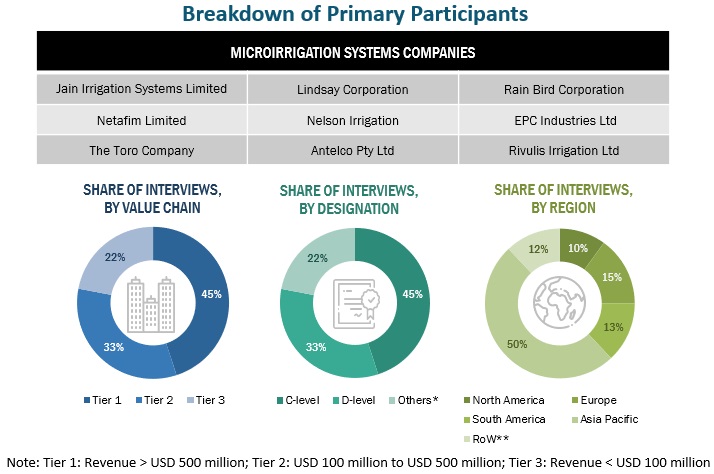
To know about the assumptions considered for the study, download the pdf brochure
Microirrigation Systems Market Size Estimation
Both the top-down and bottom-up approaches were used to estimate and validate the total size of the microirrigation systems market. These approaches were also used extensively to determine the size of various subsegments in the market. The research methodology used to estimate the market size includes the following details:
- The key players in the industry and the markets were identified through extensive secondary research.
- The microirrigation systems market was determined through primary and secondary research.
- All percentage shares, splits, and breakdowns were determined using secondary sources and verified through primary sources.
- All macroeconomic and microeconomic factors affecting the growth of the microirrigation systems market were considered while estimating the market size.
- All parameters that affect the market covered in this research study were accounted for, viewed in extensive detail, verified through primary research, and analyzed to obtain final quantitative and qualitative data.
Market Size Estimation: Bottom-up Approach
The figure represents the overall market size estimation process employed through the bottom-up approach for this study.
The bottom-up approach was implemented for data extracted from secondary research to validate the market segment sizes obtained, which is explained below:
- The market for microirrigation systems was identified based on factors, such as COVID-19 impact on the trade and supply of agricultural inputs, company presence, and their revenues and product availability; crop production, exports, and imports; the adoption of organic farming based on key crops, and average usage of drip & micro-sprinkler irrigation systems on crop application rates in the industry.
- For each country, the increase in microirrigation area was considered, along with the replacement rate of microirrigation equipment in the existing area to arrive at the market demand. This area with potential market demand was then multiplied with the average selling price (ASP) of microirrigation equipment per hectare to arrive at the country's market size. Similar ASP was considered across all the countries in the region, with certain price variations done based on product availability and export/import dependency of the country for drip equipment. After arriving at each country's market value, these market values were summed to arrive at the regional microirrigation systems market size. This was checked with the microirrigation systems market share splits provided by the industry experts. A similar approach was performed for other regions as well.
- Following this, the market size for each region was estimated by summing up the country-level data. Further, the market size at the global level was estimated by summing up the regional level data, which has been validated through primary interviews conducted with microirrigation system manufacturers, government institutions, research organizations, suppliers, and distributors.
- The global number for microirrigation systems was arrived at after giving certain weightage factors for secondary sources, and primary sources obtained.
Market Size Estimation: Bottom-up Approach
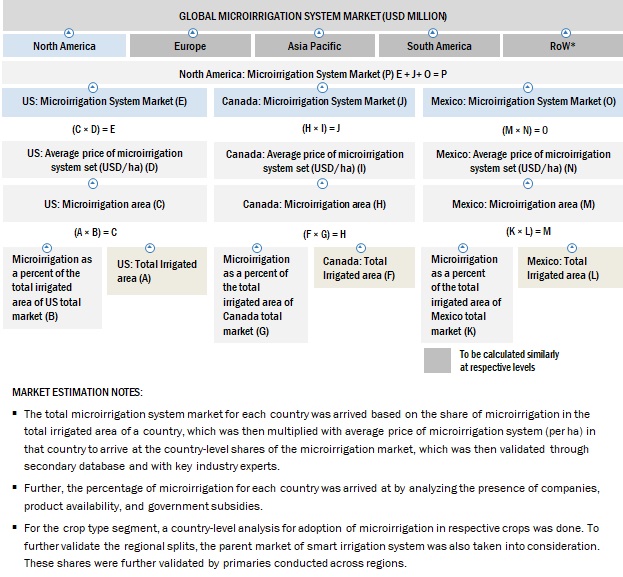
To know about the assumptions considered for the study, Request for Free Sample Report
Microirrigation Systems Market Size Estimation Methodology: Top-Down Approach
The top-down approach was used to triangulate the data obtained through this study:
The top-down approach was also implemented for the data extracted from secondary research to validate the share of the market segment obtained. For the calculation of the global microirrigation systems market, the revenues of the major players operating in the microirrigation systems market were considered. The global share of the major players in the microirrigation systems market was validated with the primary respondents. The regional splits were arrived at by considering the presence and number of products sold by the company in the particular region alongside the land area being brought under microirrigation systems.
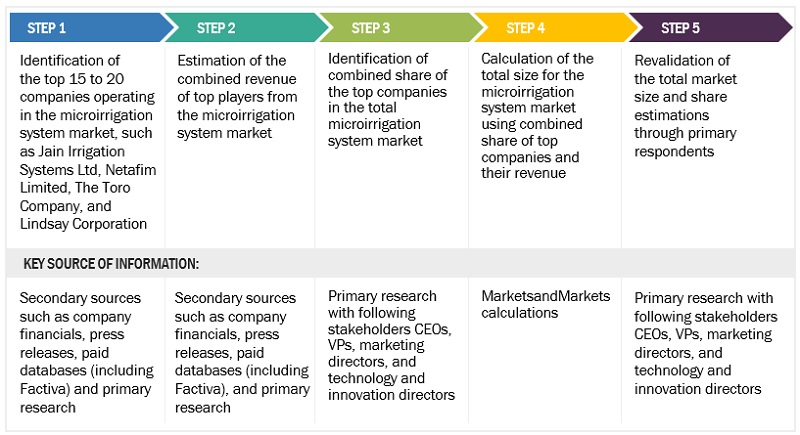
Data Triangulation
After arriving at the overall microirrigation systems market size from the above estimation process using both top-down and bottom-up approaches, the total market was split into several segments and subsegments. To complete the overall microirrigation systems market estimation and arrive at the exact statistics for all segments and subsegments, the data triangulation and market breakdown procedures were employed wherever applicable. The data was triangulated by studying various factors and trends from the demand and supply sides
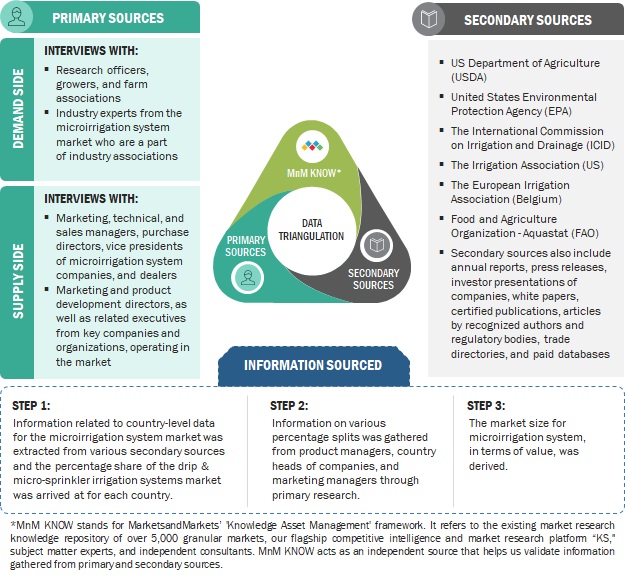
Market Definition
According to US EPA (United States Environmental Protection Agency), microirrigation is a low-pressure, low-flow-rate type of irrigation that can reduce the likelihood of overwatering a landscape. This form of irrigation delivers water directly to where it is needed most-the root zone of plants. It also delivers the water slowly and over a longer period of time, preventing runoff and reducing evaporation. Microirrigation systems use 20 to 50 percent less water than conventional sprinkler systems and can reduce residential or commercial landscape irrigation water use.
According to F.R. Lamm, J.E. Ayars, and F.S. Nakayama in the book titled ‘Microirrigation for Crop Production: Design, Operation and Management,’ microirrigation is defined as:
“Microirrigation is the slow application of water on, above, or below the soil by surface drip, subsurface drip, bubbler, and micro sprinkler systems. Water is applied as discrete or continuous drips, tiny streams, or miniature spray through emitters or applicators placed along a water delivery line adjacent to the plant row.”
Microirrigation systems include drip method and micro-sprinkler method of irrigation systems. The approach in both systems involves a controlled supply of water in small quantities with the required consistency. Microirrigation is low pressure and low-volume irrigation system suitable for high-return value crops such as fruit and vegetable crops. Microirrigation is a modern method of irrigation; by this method, water is irrigated through drippers, micro-sprinklers, foggers, and other emitters on the surface or subsurface of the land
Key Stakeholders
- Microirrigation systems manufacturers
- Microirrigation systems importers and exporters
- Microirrigation systems traders, distributors, and suppliers
- Government and research organizations
-
Government regulatory agencies
- Food and Agriculture Organization (FAO)
- United States Department of Agriculture (USDA)
- Environmental Protection Agency (EPA)
- Department of Environment, Food, and Rural Affairs (DEFRA)
Report Objectives
Market Intelligence
- To determine and project the size of the microirrigation systems market with respect to type, crop type, end user, and region
- To identify the attractive opportunities in the market by determining the largest and fastest-growing segments across regions
- To provide detailed information about the key factors influencing the market growth (drivers, restraints, opportunities, and challenges)
- To provide the regulatory framework and market entry process related to the microirrigation systems market
- To analyze the micromarkets with respect to individual growth trends, prospects, and their contribution to the total market
Competitive Intelligence
- To identify and profile the key players in the microirrigation systems market
- To provide a comparative analysis of market leaders based on the following:
- Product offerings
- Business strategies
- Strengths and weaknesses
- Key financials
- To understand the competitive landscape and identify the major growth strategies adopted by players across countries
To provide insights on key product innovations and investments in the microirrigation systems market
Customization Options
MarketsandMarkets offers customizations according to client-specific scientific needs with the given market data.
The following customization options are available for the report:
Product Analysis
- Product matrix, which gives a detailed comparison of the product portfolio of each company
Geographic Analysis
- Further breakdown of the Rest of Europe's microirrigation systems market forecast into Germany, UK, the Netherlands, and other EU and non-EU countries.
- Further breakdown of the Rest of Asia Pacific market into South Korea, Malaysia, and Vietnam.
- Further breakdown of the Rest of the South American microirrigation systems market forecast into Cuba and Uruguay.
Company Information
- Detailed analyses and profiling of additional market players (up to five)



 Generating Response ...
Generating Response ...











Growth opportunities and latent adjacency in Microirrigation Systems Market
Interested in purchasing the report, does it have data on drip sensors.
Interested in global drip irrigation market with deep dive in US, Latin America, India and China markets
Looking for the current market size of the drip irrigation sector in India.